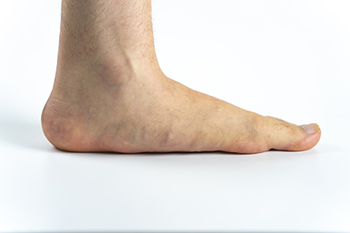
Flat feet, also known as fallen arches, refer to a condition where the arches of the feet are lower than normal or absent. This can result in the entire sole of the foot making contact with the ground while standing. The two main types of flat feet are rigid and flexible. Rigid flat feet are present from birth and occur when the arch does not develop properly. Flexible flat feet, on the other hand, develop over time and may only appear when standing or walking, with the arch returning when sitting or resting. The causes of flat feet include genetic factors, injury, or conditions like arthritis. In some cases, overuse or improper footwear can contribute to the weakening of the arches. While many individuals with flat feet experience no pain, others may develop discomfort in the feet, legs, or lower back. If you have flat feet, it is suggested that you consult a podiatrist who can help you to manage this condition.
Flatfoot is a condition many people suffer from. If you have flat feet, contact one of our podiatrists from Princeton Foot and Ankle Associates. Our doctors will treat your foot and ankle needs.
What Are Flat Feet?
Flatfoot is a condition in which the arch of the foot is depressed and the sole of the foot is almost completely in contact with the ground. About 20-30% of the population generally has flat feet because their arches never formed during growth.
Conditions & Problems:
Having flat feet makes it difficult to run or walk because of the stress placed on the ankles.
Alignment – The general alignment of your legs can be disrupted, because the ankles move inward which can cause major discomfort.
Knees – If you have complications with your knees, flat feet can be a contributor to arthritis in that area.
Symptoms
- Pain around the heel or arch area
- Trouble standing on the tip toe
- Swelling around the inside of the ankle
- Flat look to one or both feet
- Having your shoes feel uneven when worn
Treatment
If you are experiencing pain and stress on the foot you may weaken the posterior tibial tendon, which runs around the inside of the ankle.
If you have any questions please feel free to contact our offices located in Princeton, and West Windsor, NJ . We offer the newest diagnostic and treatment technologies for all your foot and ankle needs.
